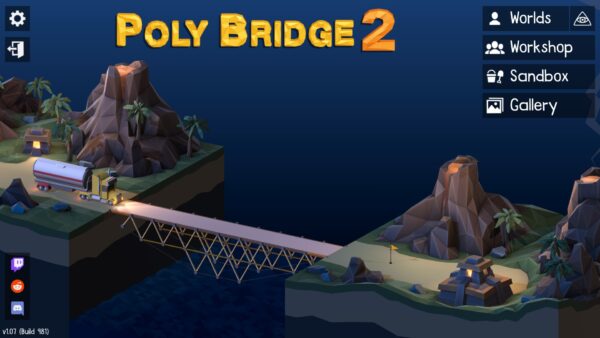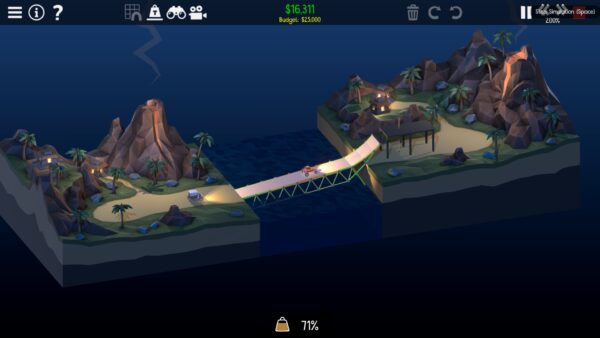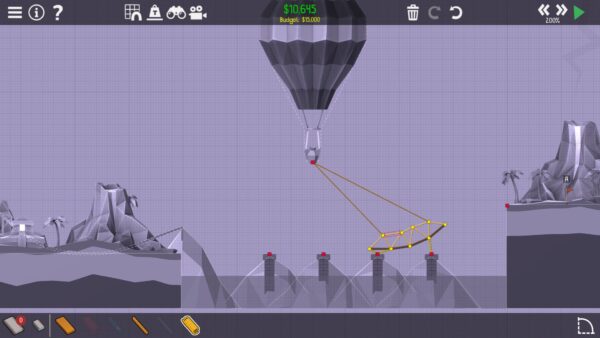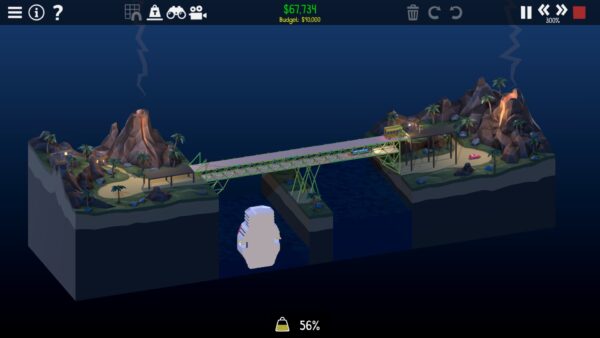There’s going to be a bit of a theme for the next few reviews because I had a hankerin for something specific: a building game. Now I’m not quite sure what triggered this, nor could I describe exactly the kind of game would hit the spot at the time, but it sent me on a quest to see what the latest releases were and if they’d be the one for me. So the first cab off the rank for this is Poly Bridge 2 which I was aware of but never got around to playing. I’m no stranger to the simulation gone wrong genre though and I figured it’d at least be worth a few good chuckles, if not something to tickle my engineer brain for a bit. It managed to do both and while the charm wore off after a while it was a good bit of fun while it lasted.

The premise of the game is very straightforward: you have to get whatever is on the one side of the screen to the other without them meeting some sort of catastrophe along the way. This starts off as a simple exercise in bridge building, ensuring that whatever structure you plonk down doesn’t collapse in on itself before your cargo makes its way across it. From there though, as more mechanics are introduced to you, it becomes this intricate puzzle that starts out with just solving it but then invites you to try your hand at optimising it. Whilst I can’t lay claim to any real fame in my bridge designs I can say that adding that small competitive element was enough to keep me engaged for far longer than I otherwise would have been.
The graphics of Poly Bridge 2 are the tried and true simple, low poly and texture approach that many indie games use. There’s a few little splashes of lighting effects and whatnot around the place but it’s very clear that the focus of the game isn’t the visuals. This actually works in its favour however, focusing you in on the job at hand rather than trying to dazzle you with fancy graphics. I don’t believe the physics simulations are particularly heavy either, so the visual style is most certainly deliberate rather than out of necessity. Overall I quite liked the visuals and the somewhat soothing soundtrack (which did start to grate on me during repeated failures).

The game does a good job of introducing you to the basics; I.E. triangles are the strongest structure and deviating from them will likely be at your peril. The additions of things like springs, hydraulics and ropes is done well enough that you’ll likely be able to solve the first puzzle they appear in without too much drama and integrate them into your problem solving tool kit right away. Some of the quality of life things aren’t introduced as well unfortunately, which can make the game’s opening hours a little more frustrating if this happens to be your first introduction to the series (as it was mine). Past a certain point though you’ll have a pretty good rhythm going for puzzle solving and then you can focus solely on the challenge.
The puzzles aren’t necessarily sequenced in easiest to hardest as, at least to me, there were some puzzles that basically broke me for a good while whilst another follow up one was completed in no time at all. Thing is though, and this is probably one of the most clever parts of Poly Bridge, you can basically “solve” the puzzle however you like as the game won’t stop you from building it out (apart from a few puzzles which limit certain items). For me this was pretty great as it gave you the opportunity to see at least one solution before you went back and tried for the trifecta the game wants you to achieve: under budget, no breaks and with everything successfully seen across the gap.

The addition of the leaderboard though is the real genius of it. Whilst it stopped working for a couple of my sessions when it was up seeing where I ranked among everyone else was a pretty great motivator for me to go back and optimise the solutions. Better still being shown a few, completely different approaches to the puzzle meant that I was able to build up my own knowledge about how to solve certain things or how to optimise builds to the nth degree. Given a little bit of effort it wasn’t too hard to get into the top 10% of players, although getting much beyond that obviously involved doing things that I hadn’t yet grasped.
I would like to see the editor and control scheme improved a little bit as it felt a little bit clunky to use. Building out the initial triangle bridge sections was always a chore and, so it seems, there’s a copy and paste function that I was completely unaware of. Moving whole sections of bridge around also doesn’t seem to be a thing, which can be rather irritating as you’ll have to move individual joints around in order to move that one piece you wanted to shift. None of these things stopped me from getting where I wanted to go, it was just a little more annoying than I would’ve liked it to be.
In the end the reason I stopped playing was just because it got kinda repetitive. Solving the various problems the game throws at you is pretty fun for a while, long enough for the asking price to be worth it in my opinion. But after a while the similarities start to become a lot more noticeable and I frankly just lost interest. This is nothing really against the game though, just that it was clear after a few hours that my time with this game had a definite end date.

Poly Bridge 2 ticks all the right boxes for a simulation game like this: it’s easy to get into, incredibly hard to master and has the potential for fun physics based shenanigans that we all know and love. The game does a good job of introducing all the core mechanics but fails to give you a good lesson in the quality of life features that will make the whole experience a little less cumbersome. The leadership board is a great tool to keep competitive people like myself interested in the game and being shown other solutions makes for a great way to increase player knowledge without having to teach it to them directly. Whilst I might not have spent long with Poly Bridge 2 I feel pretty satisfied with where I got to it and may even go back from time to time should I get the itch again.
Rating: 8.0/10.0
Poly Bridge 2 is available on PC right now for $21.50. Total play time was 5 hours with 27% of the achievements unlocked.



